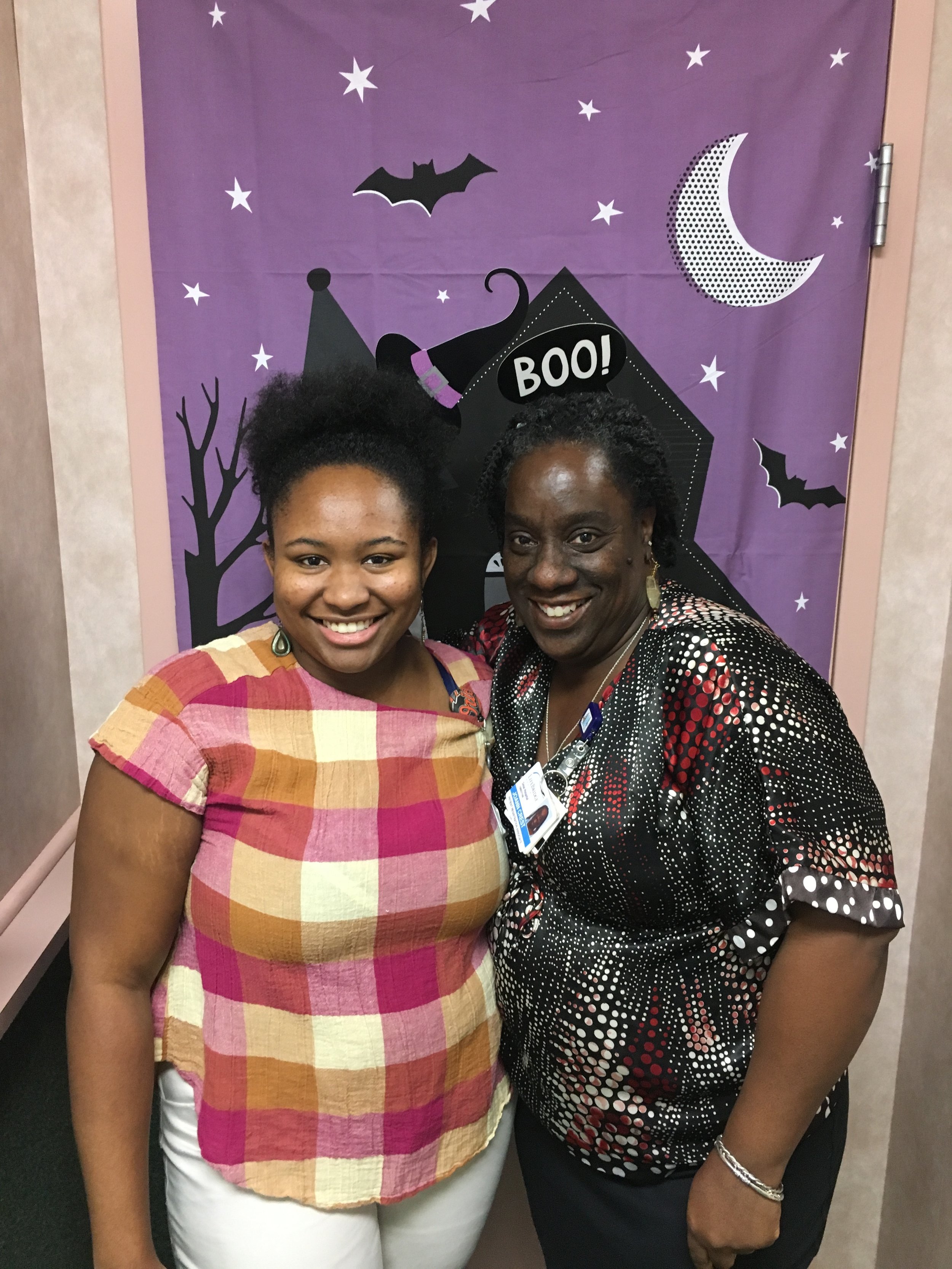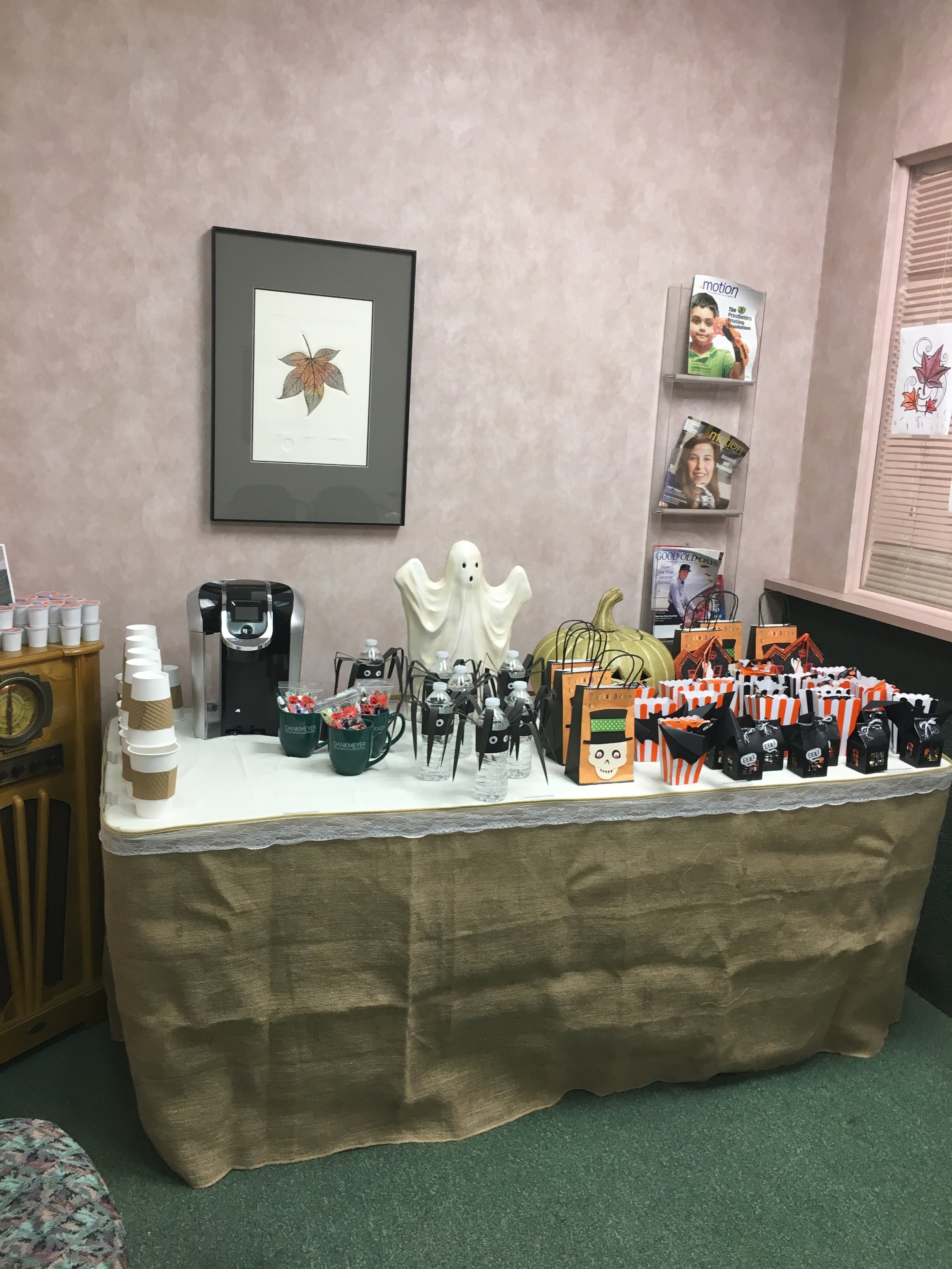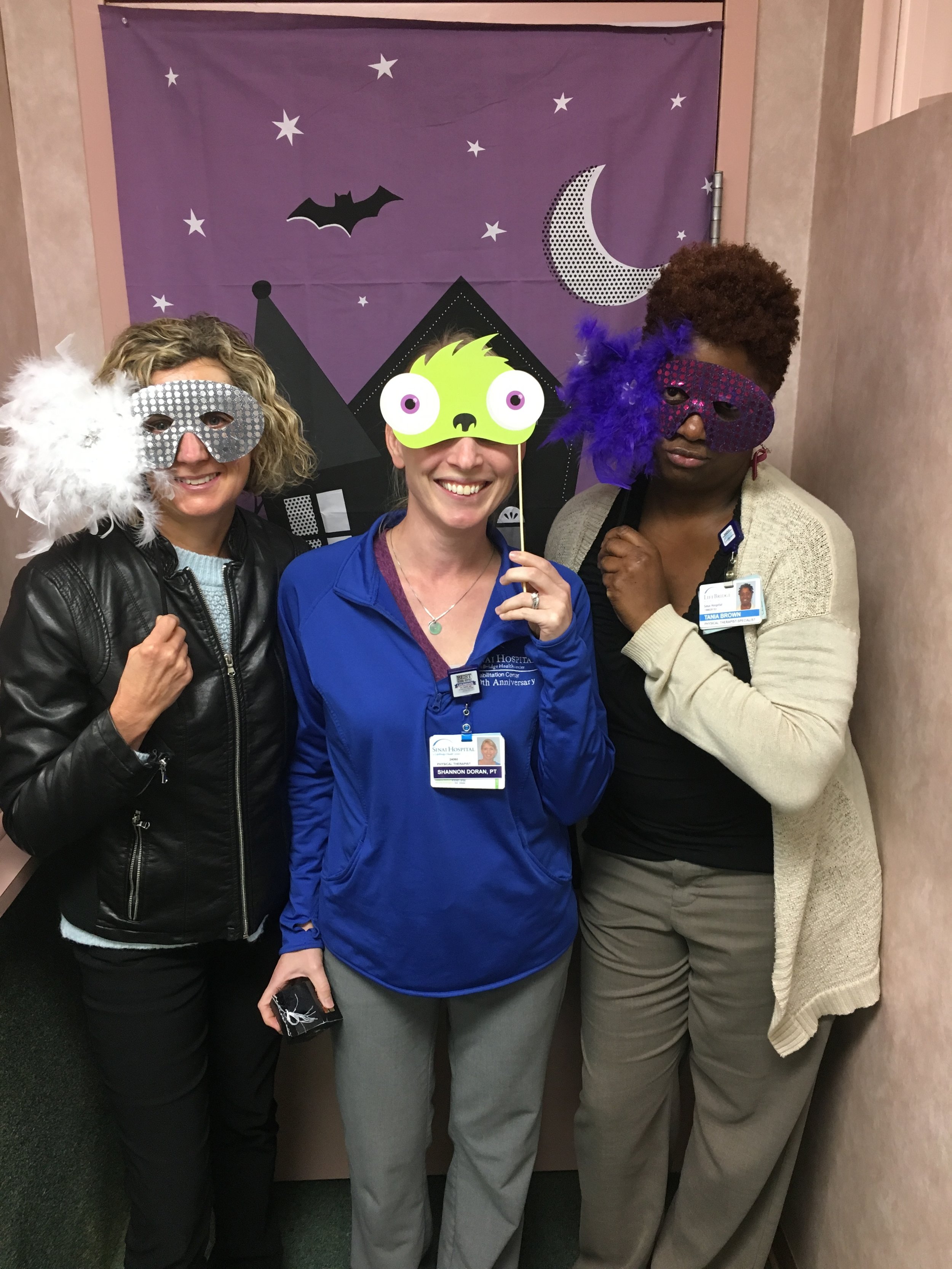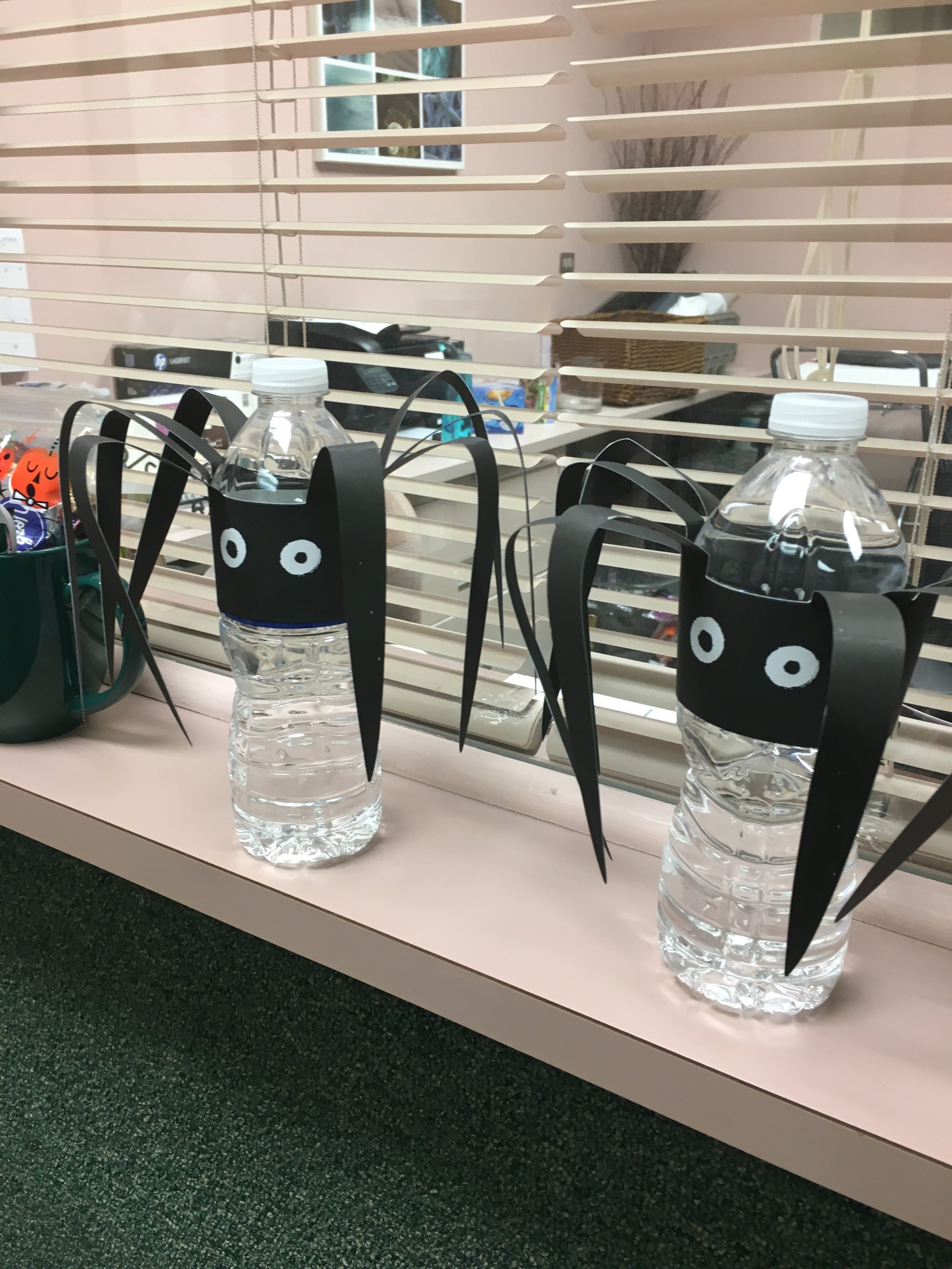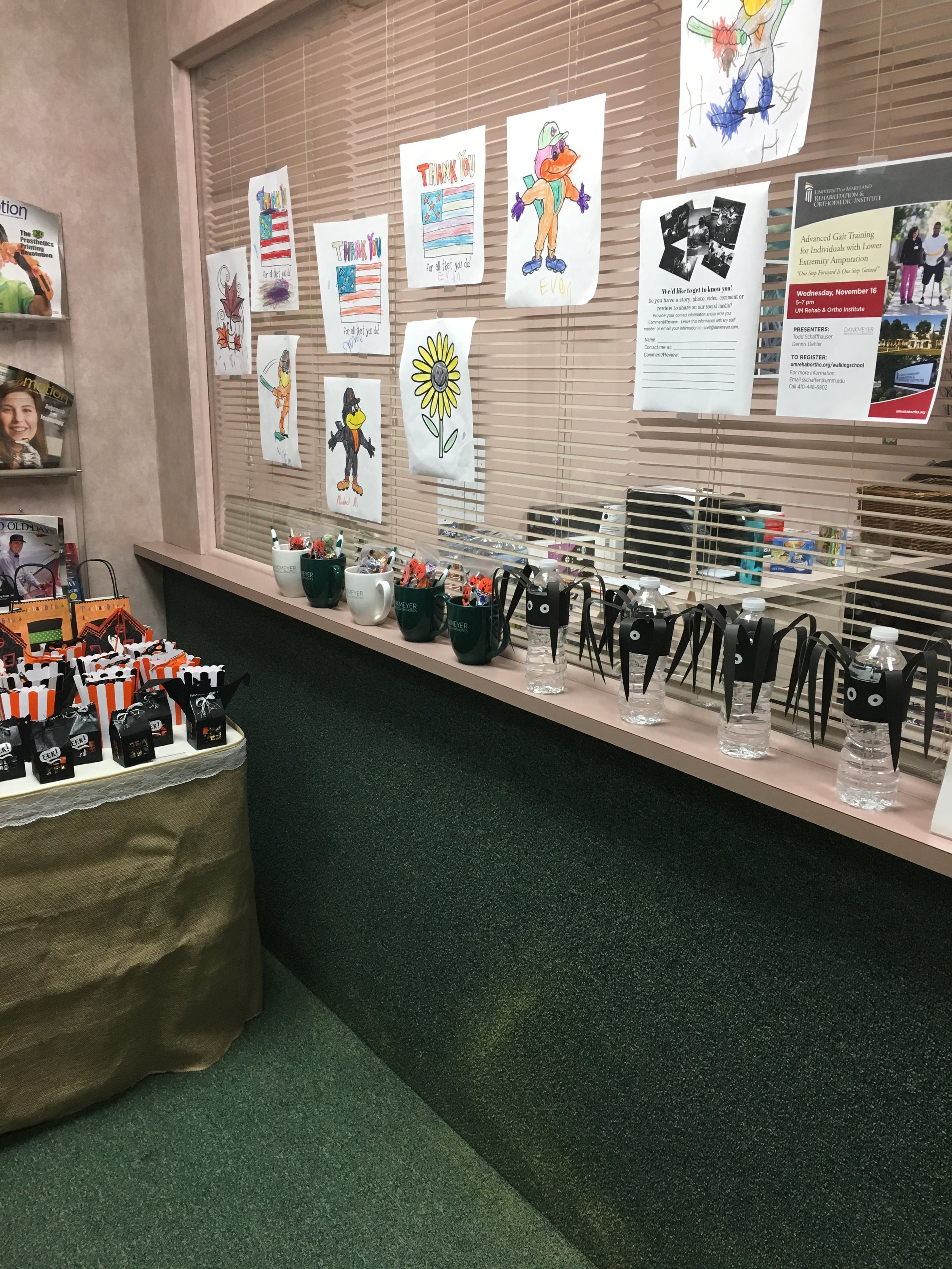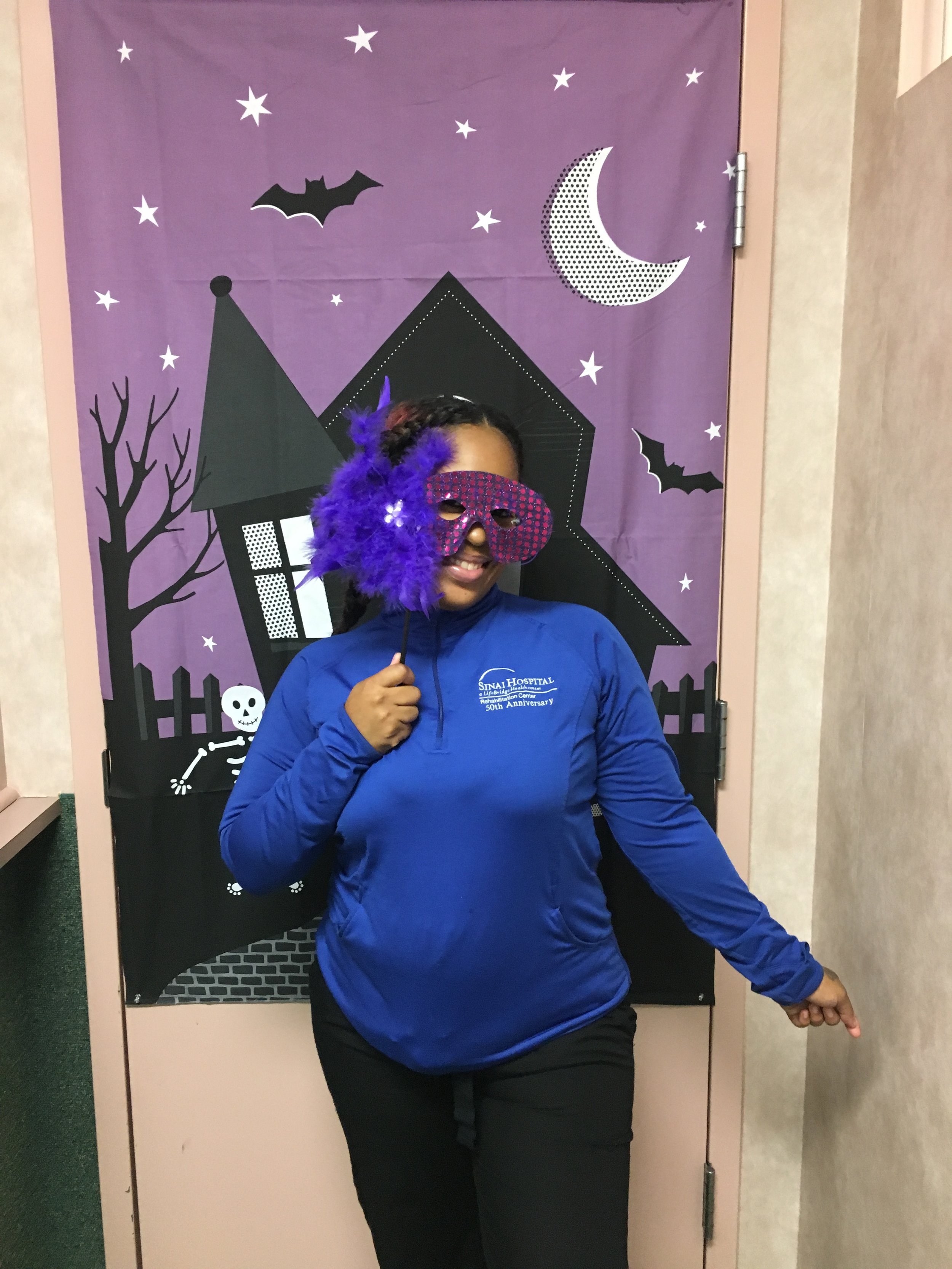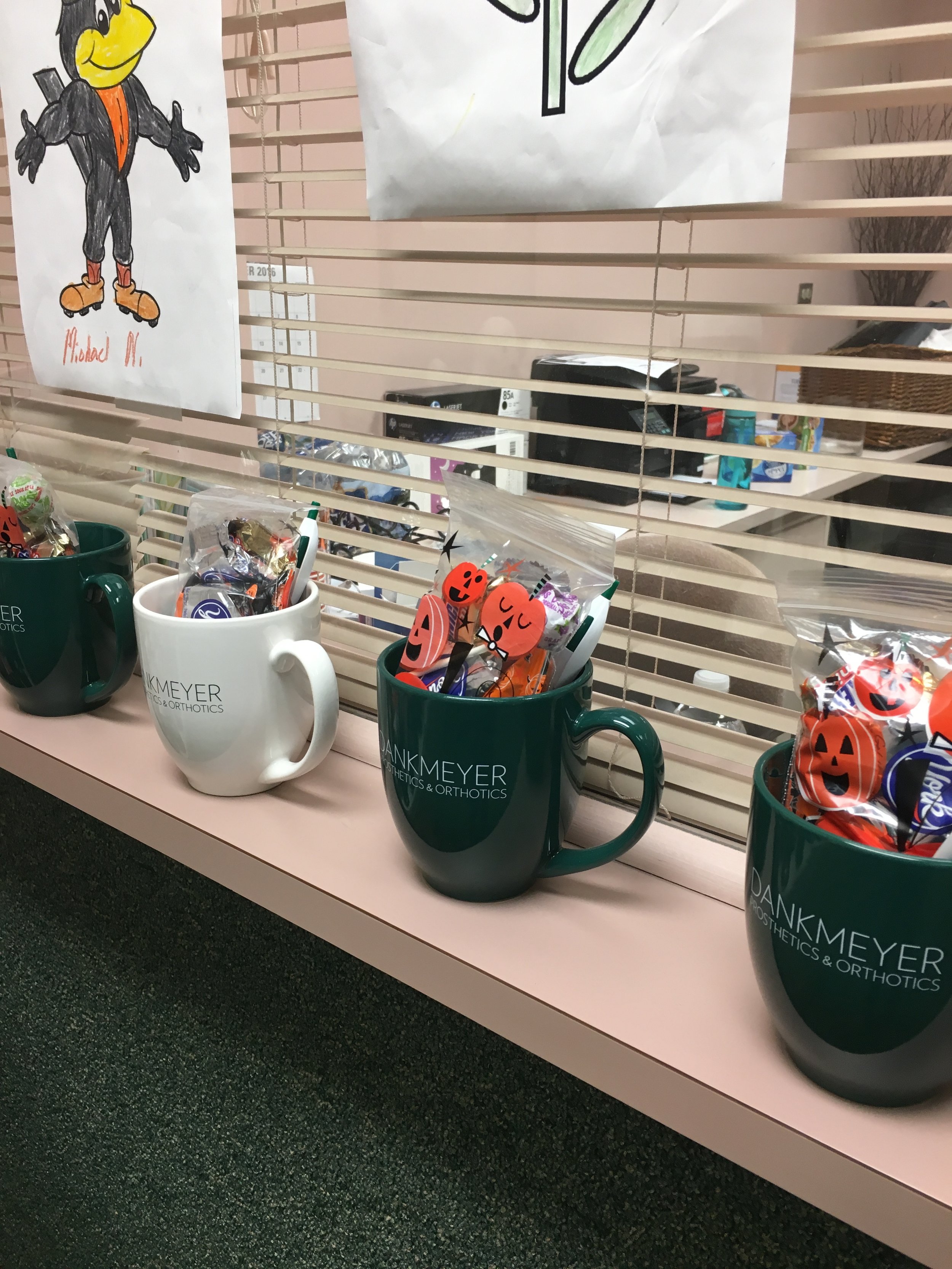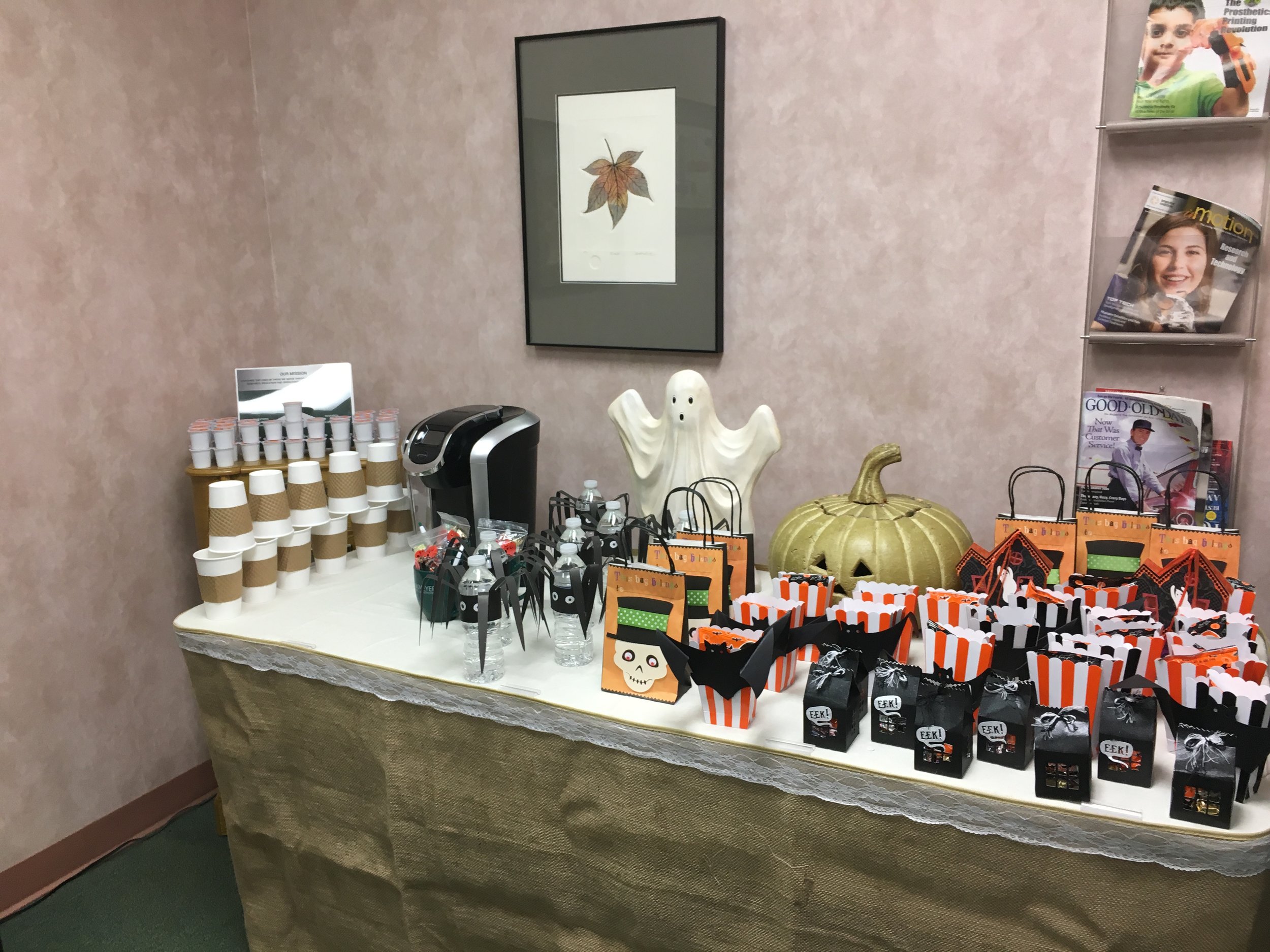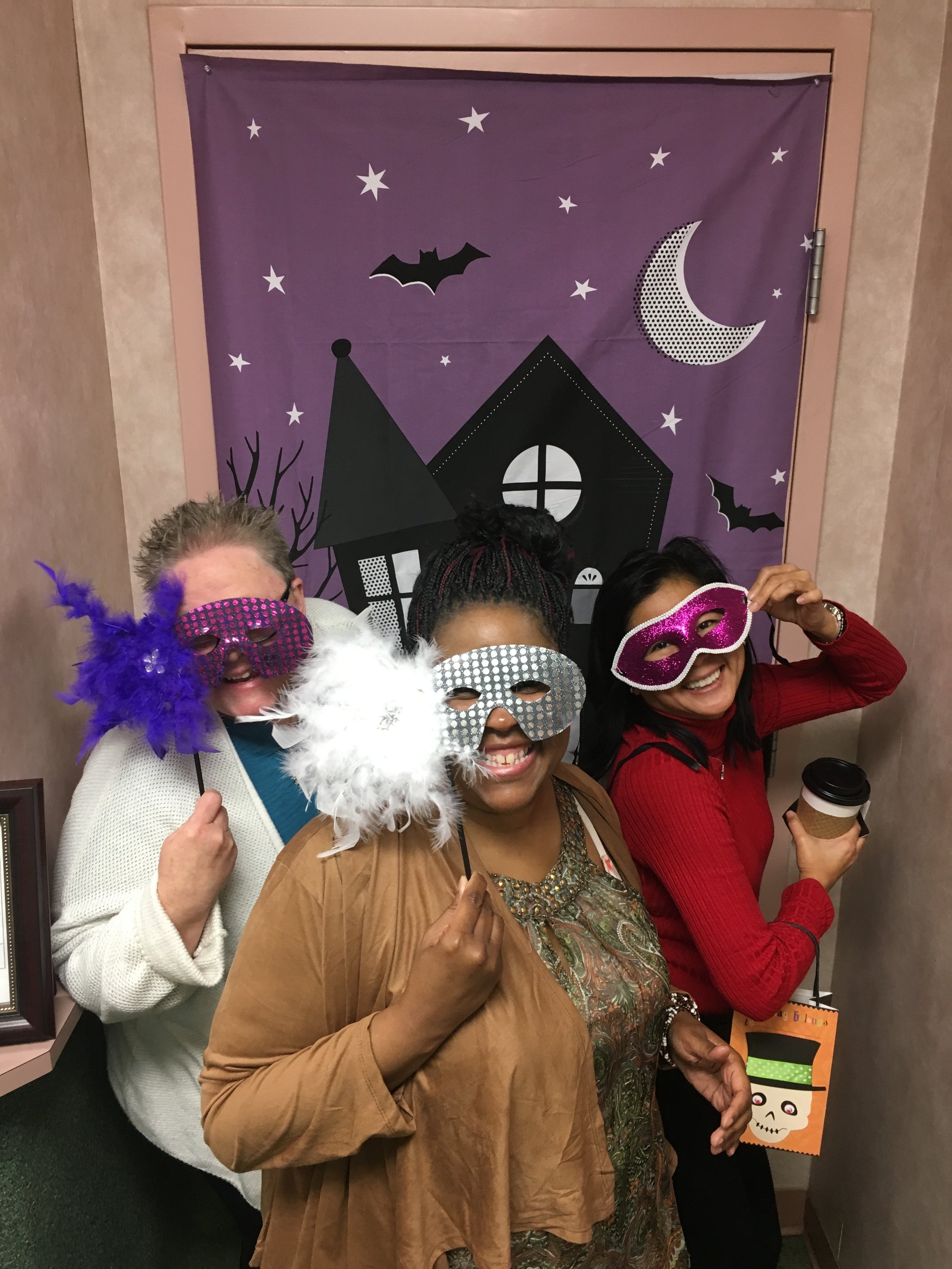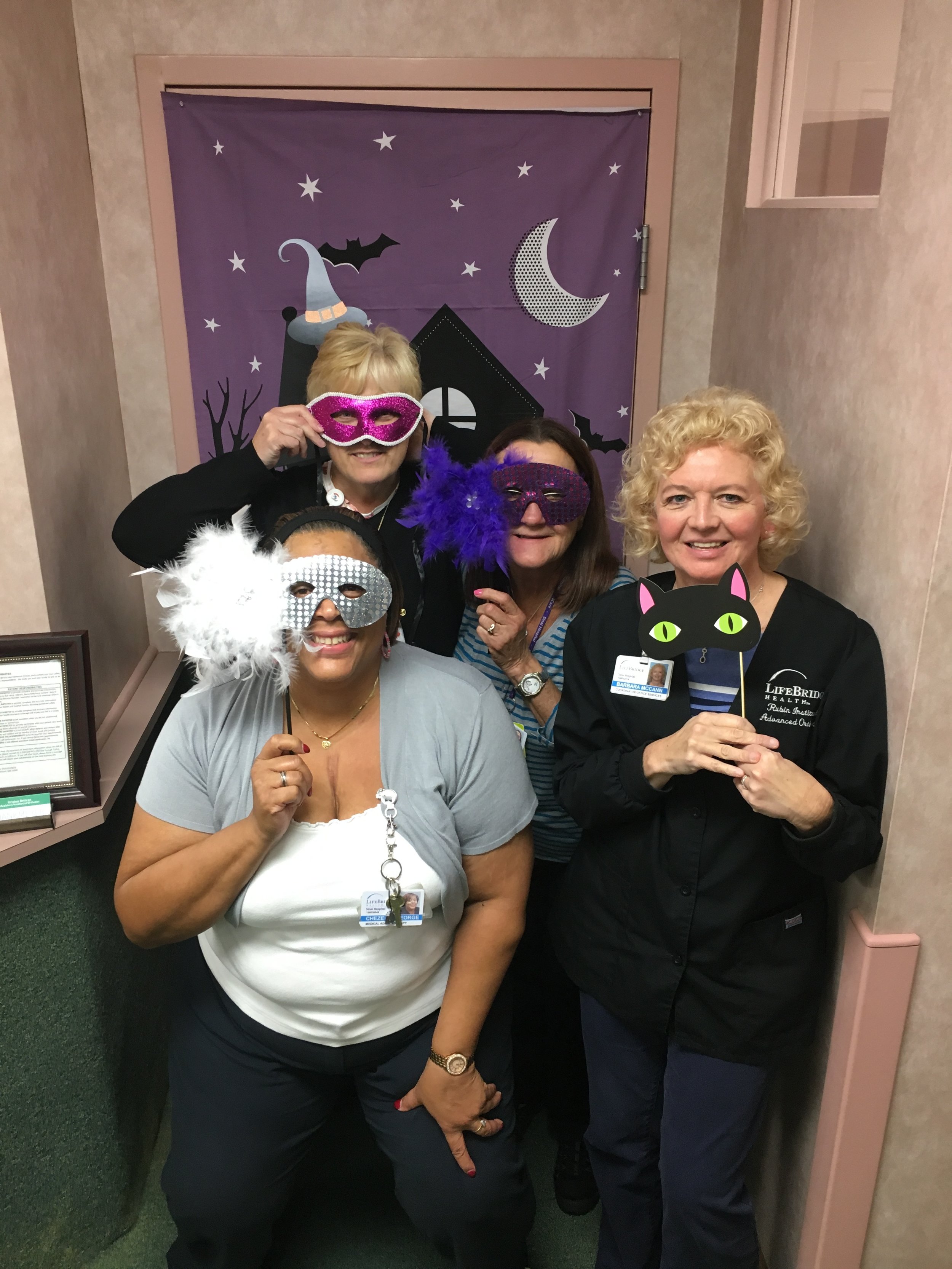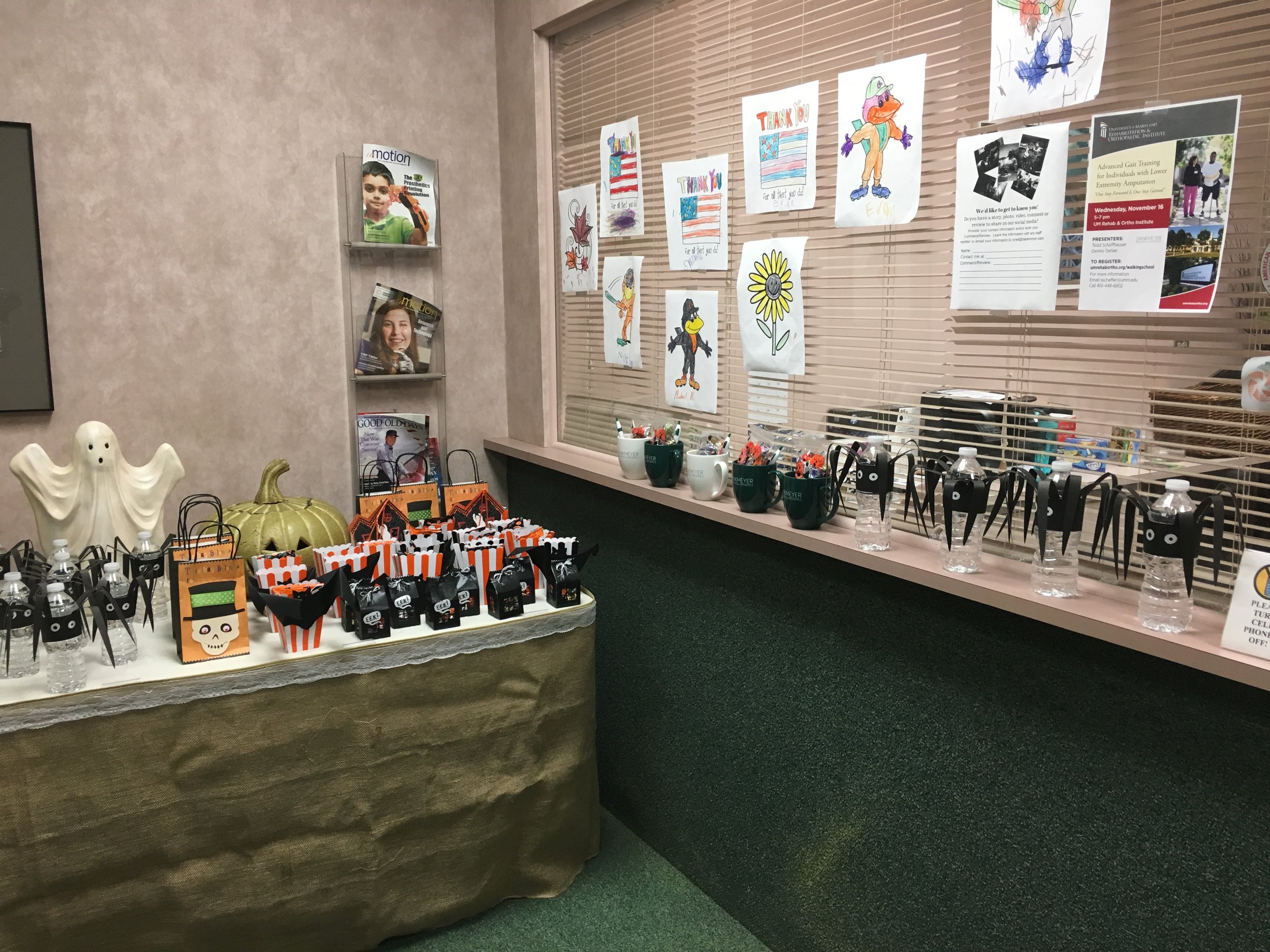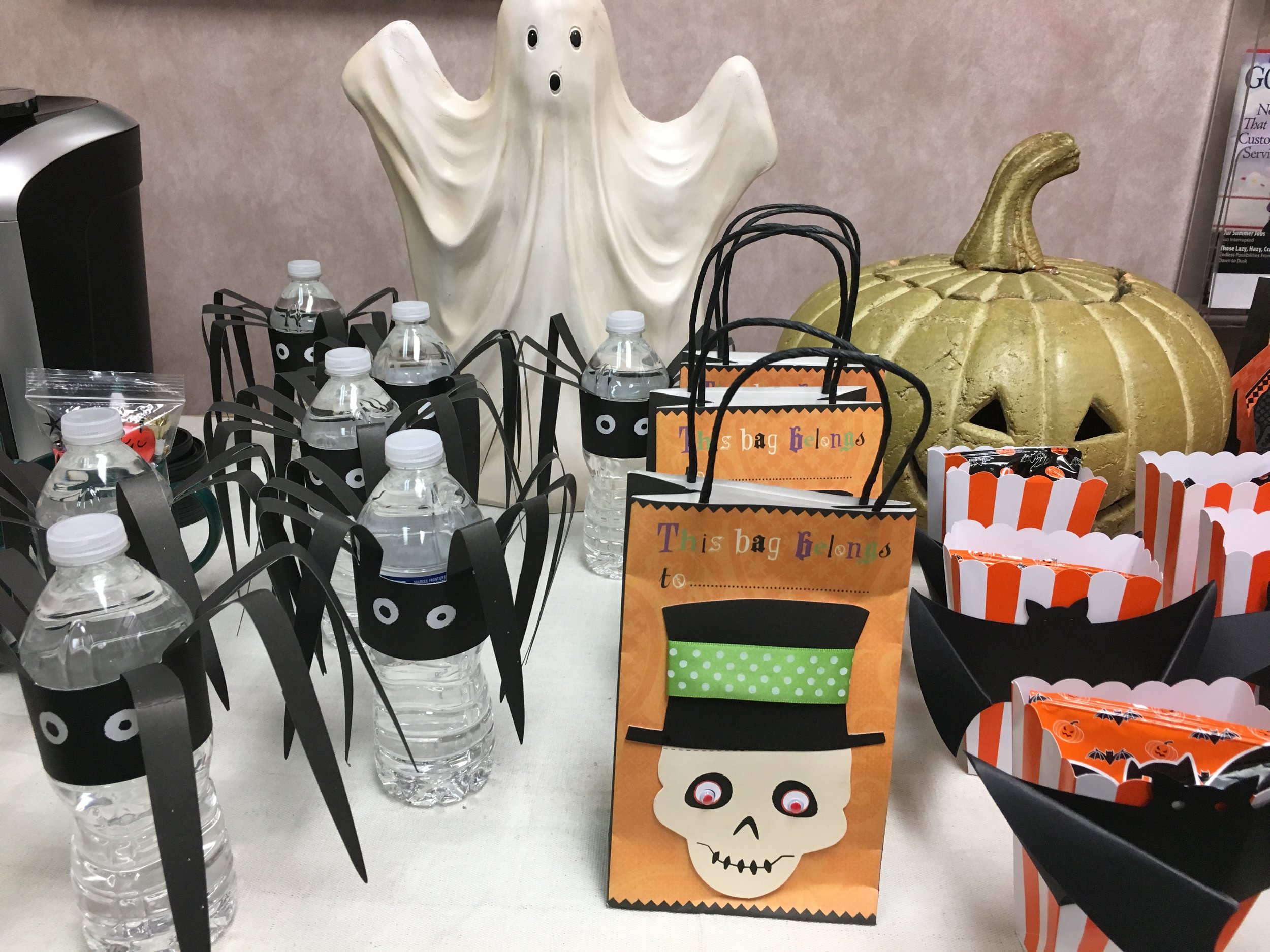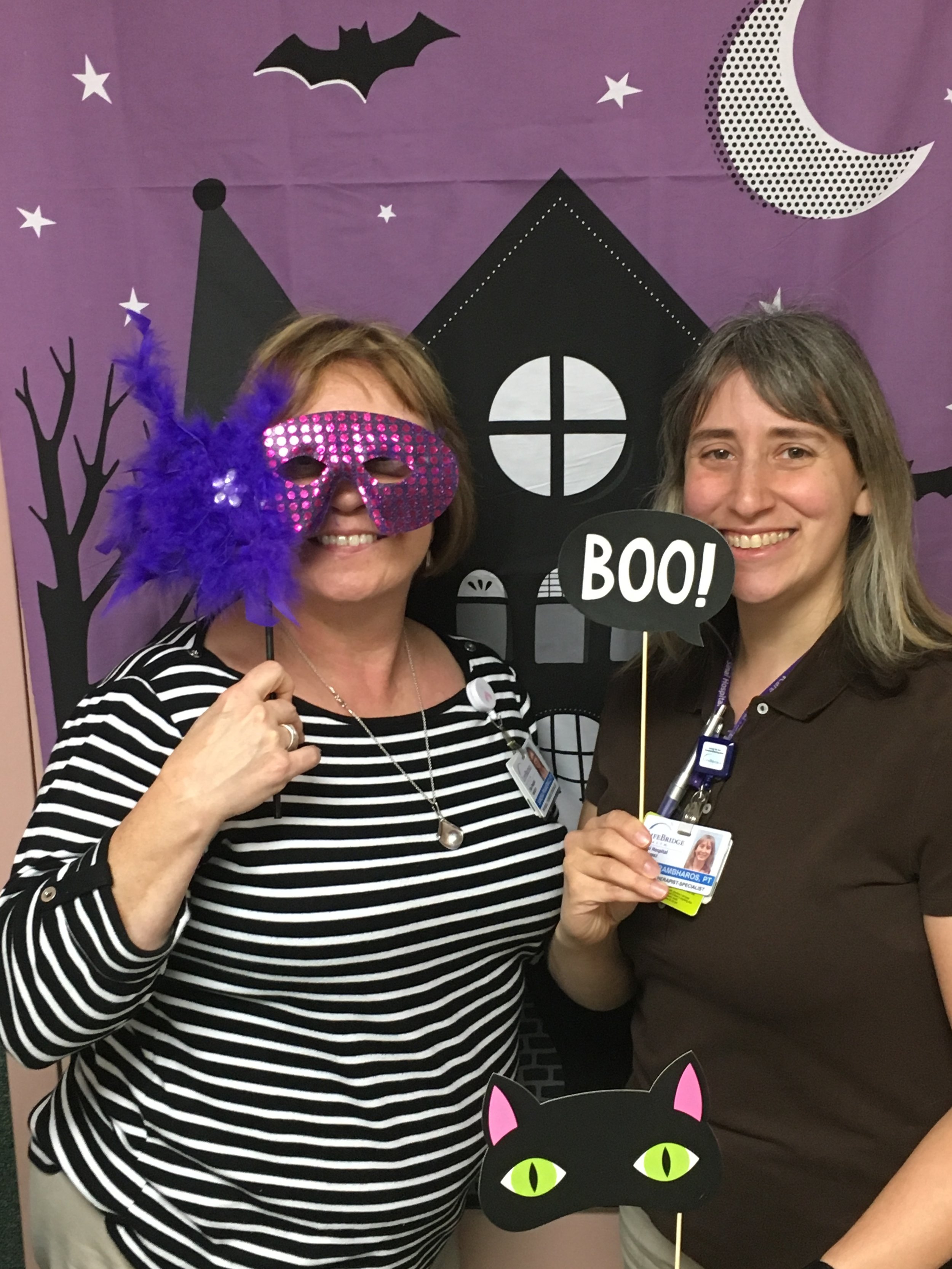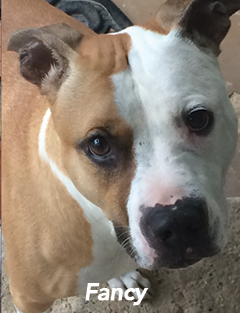Last week, on Thursday 10/27/16, we hosted one of our Coffee with Dankmeyer events at our Sinai office. Located in the Morton Mower building on the Sinai Hospital campus in Suite 107, we invite all Sinai professionals to drop in, see our facility and become familiar with our services. Since we were so close to Halloween, that was our theme, and Sheryl Nathanson CPO, Jeanne Smith from Patient Services and Practice Liaison Toni Robinson played hostess to a number of guests. Here are some fun pictures to share.
No Tricks! Just Treats!
Dankmeyer offices will be hosting some Fall and Halloween fun next week, October 24 - October 31, Halloween day. Each office will have a few events sure to bring a smile to patients and families - like this guy is smiling! Well, maybe not so scary - we are very friendly folks at Dankmeyer. This is one of the pumpkins from last year's employee pumpkin carving contest - and we welcome your votes for this year's contest! The pumpkins will be on display Thursday and Friday 10/27 and 10/28 in the Linthicum office. And, if they don't disappear over the weekend, they will still be there on Halloween. Winners of that contest will be posted on our Facebook page.
If pumpkins are not your thing, except maybe in some pie - you could guess how many candy corns are in a jar - and submit your guess in order to win a prize. Each office will have a $25 Visa card waiting for the patient who comes in and makes a guess closest to the number of candies in the jar. Those winners will be announced on November 1, 2016. So, don't be bashful, like this guy, and take a guess. If you didn't see this one last year, this was another entry in the pumpkin carving contest.
We will also have some sugar free candies for anyone who feels like they might like to pop something into their mouth while they are in the office - like this character. Yes, you guessed it - another creative carving from last year! We will have some fun trivia on the display board in the Linthicum office, and employees might be disguised themselves on Halloween day. And, if a patient or family member comes into any office on Halloween day in costume, we have a special treat for you!
Come join the fun!
Adapted Sports - More than Paralympics
Basketball, tennis, scuba diving, skiing, water sports, golf, and so much more – these can all be adapted for individuals with physical disabilities. Many people who have disabilities are unaware that their sports and leisure activities of choice can be adapted to meet their needs, whether it’s participation in a wheelchair, modifying/adding equipment or modifying the rules. For example, in tennis, playing in a wheelchair and having two bounces instead of one are allowed. Snow skiing can be done with one ski (for amputees), in a sit ski, or can have outriggers for extra support and stability. Lower limb amputees can ski with two standard skis while using a prosthesis.
In this picture, Eric Flynn is showing off some skis that have been adapted for his use. The ski binding attachments were made by Enabling Technologies of Colorado.
Dankmeyer, Inc. modified the binding attachments for direct attachment to Eric's prostheses. Baltimore Ski Warehouse, a local ski shop, set up the skis and bindings. There are ski specific feet that could be used; you can see those by clicking on either of these links: Freedom Innovations and Otto Bock. Or, Eric could have used more standard prosthetic feet and ski boots. There are many options for adapting ski equipment or other sports equipment for prostheses and it takes a TEAM to find the right solution at the right time for a specific person. This is a very practical solution as it is simple and durable and was just the right solution for Eric for his first ski outing. He did so well, we will have to see how we can support his interest in the sport and make sure the equipment keeps up with him!!
Sports can be done with prostheses/orthoses or without, depending on the participants’ choice and comfort level. Some sports, including tennis, can be done alongside individuals without disabilities. Variations on rules and equipment are based on types of disability and are sport-specific. Previous patient story Jenny Windsor trained for months to compete in her first Rugged Maniac challenge, involving a number of obstacles for running, climbing and jumping and mud. This required a great deal of stamina and upper body strength to complete. She worked carefully with her prosthetist to make sure she was prepared.
Participation in adaptive recreational or competitive sports provides tremendous physical and emotional health benefits, including those related to a healthy weight, improved quality of life, and decreased stress. It also provides opportunities for social interaction with people who have had similar life experiences and with their peers who do not have a physical disability.
An acquired disability does not mean that the individual cannot do a sporting activity that they enjoy, whether it’s competitive or recreational. Athletes do not have to be Paralympians to participate, and everyone with a physical disability is welcome. Individuals may want to try something that they haven’t ever tried before, and sometimes an adapted version is a great way to get introduced to a sport. Many local and national organizations offer opportunities to learn new activities and participate at recreational and competitive levels. Some of these include:
- University of Maryland: http://umrehabortho.org/programs/adapted
- Kennedy Krieger: https://www.kennedykrieger.org/community/adaptive-sports-program
- Disabled Sports USA local chapters: http://www.disabledsportsusa.org/locations/
- Baltimore Area Recreation and Sports: http://www.barsinfo.org/
- Baltimore Parks and Recreation adaptive programs (therapeutic recreation): http://www.baltimorecountymd.gov/agencies/recreation/programdivision/therapeutic/index.html
- Howard County - https://www.howardcountymd.gov/Departments/Recreation-and-Parks/Programs/Therapeutic-Rec
On September 10, 2016, the University of Maryland Rehabilitation and Orthopedic Center hosted the 8th annual Adaptive Sports Festival, which provided an introduction to adaptive sports to the local community with physical disabilities as well as present and past patients. It was a great way for individuals to learn about local programs, resources, and adaptive sports teams. It also was a great way for individuals with disabilities to meet peers who can understand the lifestyle changes and challenges they face.
The Paralympic Games occur in parallel with the Olympic Games, where athletes from all over the world with various types of disabilities compete. In fact, they are happening now in Rio! They originally started following World War II for veterans and civilians with disabilities and grew from there, incorporating a wide variety of athletes with disabilities. The Paralympics serve as a celebration for competition and provides motivation for individuals who may not necessarily be athletes realize that anything is possible despite having a disability. Read more at https://www.paralympic.org/ and watch on NBC. The Paralympics occur from September 7-18.
For an amazing video of the kinds of sports and athletes that will be in the Paralympics, click here.
If you have any questions about how YOU might participate in a sport, either in an adapted fashion or not, then let your clinician know.
- Kristen Beltran, Resident Prosthetist, Orthotist
School Days, School Days
As summer winds down, and we see the days shorten, once again it is time for school to start. We get up earlier, and we pack up backpacks and lunches and sharpen pencils. We anticipate the start of homework, and cooler weather and football. All over the country, at various points in August, the busses start rolling, and school zones light up, and summer is essentially over - after we have our fill of the Olympic Games (and Paralympic Games in September!)
And yet, there was summer school for some and there is always lots of continuing education. After having three high school seniors here last school year working on their senior projects (you can look through our previous news articles for this) Dankmeyer hosted a number of student interns over the summer. We taught various courses at several graduate programs, hosted a few inservice projects, fielded a few speakers, and in the last six months many staff members have attended or participated in various learning conferences, seminars and webinars. Remember when we used to start the school year as youngsters and we had to write a report on "what we did last summer"? We thought you might enjoy a similar report from us! Since there is no quiz, you can skip around and read whatever might interest you.
At Home Schooling
Let's start with the student interns here this summer. Dankmeyer kicked off its first summer Student Orientation to O&P Internship program. The program gives high school students, college students, and recent graduates an inside look into the orthotic and prosthetic field, by providing them with clinical and technical observation hours, education and an O&P related project. This summer we had two sessions, both full, each running four weeks. Summer yearbook pictures for first term show (from the top, left to right) Haley, Sean, Jacob and Natasha.
In case you missed it, back in April we posted a story about our involvement in the 3D printing E-Nable project with Anne Arundel County schools. You can read here about that project and the STEM students involved. Kristen Beltran, a first year Prosthetic and Orthotic Resident at Dankmeyer, was our liaison with the project. Dankmeyer continues to explore 3D printing options and how we might use those to benefit our patients. We have a 3D printer we are using to print small objects and some of the E-Nable designs like the hand (shown here) we provided to one junior patient. In addition to that, Kristen and CPO Jed Newhardt are participating in a beta test of some new software which can be used to analyze scans of limbs. The scanner they are using is attached to an iPad, and the results are recorded in the software to produce a 3D image of the scanned residual limb. This image can be modified without using plaster casts, or even physically being in the lab - eventually leading to produce a socket.
Professional Continuing Education
While Kristen has been with us about a year, as has resident Nina Bondre, we also welcomed two new Prosthetic and Orthotic Residents to Dankmeyer as they begin the next phase of their educations - Robert Tyler and Kelsey Kasten. As the "senior" resident, Nina took a few moments to write for our report, as she describes the education process for a Prosthetist/Orthotist:
There are several steps to becoming a Certified Prosthetist Orthotist (CPO). A BS or BA is required to apply to Master's programs in O&P. While no particular major is required, certain prerequisites must be fulfilled in order to apply to the Master's programs. These prerequisites include physics, chemistry, and life sciences with a lab component. There are several Master's programs across the country, approximately a year and a half long in length. The Master’s programs include anatomy, biomechanics, fabrication, and clinical decision making coursework. Students are able to interact with patient models regularly in order to hone and sharpen their clinical skills and practice working in a patient care environment.
Once the Master's program is finished, a residency and board exams must be completed before certification can be acquired. A residency must be completed in orthotics and prosthetics, and can be combined or pursued separately. Residencies can take either 18 months or 24 months to finish. Once residency is completed, candidates may sit for board exams to become certified. After the CPO certification is acquired, practitioners must participate in continuing education to maintain their certification. Continuing education often includes attendance at conferences and courses that are offered to teach practitioners about new technologies and methods in the field. At Dankmeyer, the credentials of our certified clinicians are proudly displayed where patients can see them on the way to exam rooms.
Sheryl Nathanson, CPO recently completed her course of study to become an approved Clinical Mentor with the National Commission on Orthotic and Prosthetic Education (NCOPE). NCOPE is a professional organization that focuses on overseeing the education of new students and residents entering the field.
Interdisciplinary Fields
While we individually work on continuing education, Dankmeyer, Inc. is committed to enriching the lives of all those we serve in the community. This, of course, involves working directly with our colleagues on the health care team such as physicians, physical and occupational therapists, nurses, case manages and many others. We have made a big commitment to education and provide the didactic training for several of the local physical therapist and physical therapist assistant programs. We recently completed one such session of teaching at the University of Maryland Physical Therapy and Rehabilitation Science Program where we provided approximately 35 hours of direct instruction in lecture and lab on the application of orthoses and prostheses in rehabilitation. We provide a similar set of lectures and labs for the University of Delaware Physical Therapy Program which typically takes place in the Fall and for the Physiatry Residents at Sinai/University of Maryland and Johns Hopkins PM&R Residency Programs. Mark Hopkins and Angie Bryl both have Adjunct Faculty Postions at the University of Maryland and Mark has a second Adjunct Faculty position at the Johns Hopkins Medical School in the Department of Physical Medicine and Rehabilitation and a guest lecturer role at the University of Delaware. In addition to those programs, we provide instruction for the Physical Therapist Assistant Programs and Baltimore City, Howard and Harford Community Colleges.
Another event we look forward to in the fall will be held at Anne Arundel Medical Center (AAMC) on November 19, 2016. Titled "Trans-femoral Prosthesis Prescription and Training Considerations: An Update", our Mark Hopkins is a featured speaker along with Amputee Walking School (AWS) favorites Todd Schaffhauser and Dennis Oehler. Here is more information and registration for the AAMC event.
Our Practice Liaison, Toni Robinson, also works to provide less formal In-Service events. By doing this, we offer opportunities for our referral sources to meet face-to-face with our practitioners. These meetings can be a small group Lunch and Learn, or an In-Service for a larger group or department. Toni reports that in July we conducted an In-Service at Sinai Hospital of Baltimore. The Comprehensive Inpatient Unit hosted us but there were a few others in attendance including staff from Acute Care. Our practitioner Sheryl Nathanson and Toni were able to cover several topics including our pre and post amputation evaluation service offerings, Medicare documentation compliance requirements, and literature that’s available to assist new amputees on our Patient Navigator page. Sheryl also spoke about the need to proactively connect inpatients with outpatient services including the Orthotics and Prosthetics Clinic located there at the hospital. One topic of discussion was the importance of linking inpatients to the clinic prior to discharge to improve the continuity of care and communication among the patients various service providers. We work to make sure we are a part of the patient health care team. Attendees were encouraged to utilize the clinic as now more than ever, we are all challenged with being good stewards of how the health care dollar is being managed. (For more specifics on a variety of other In-Service offerings, click here.)
Sometimes we are asked to participate in some very informal educational events, such as the career day that prosthetist Mary Reedy went to. This event had a number of very important future prosthetists, orthotists, doctors, nurses, physical therapists, firemen, policemen, dancers, musicians, engineers, teachers, scientists, veterinarians, and you name it - a LOT other professionals in attendance.
Patient Education, Too
While Dankmeyer is always working on ways to provide reference tools to help educate our patients about any number of topics (Care and Use Documents and Patient Navigator documents available on our website), we also regularly co-host a number of events geared toward patients. We co-hosted the summer session of the Amputee Walking School in June, and look forward to the next session of this popular program on November 16, 2016. This is for patients to continue in their efforts at advanced gait training.
Sometimes patients engage in their own learning discoveries. Some patients attended the Amputee Coalition's annual meeting in June. Other patients or patient family members undertook day-long Certified Peer Visitor training this summer when classes were offered by the Amputee Coalition as part of the AWS summer session. We also recommend the Adapted Sports Festival offered by the University of Maryland Medical Center on September 10, 2016 for those who want to learn more about adapted sports. Dankmeyer is always there with an information table, and to volunteer support. By that time we will be in the thick of the Paralympic Games in Rio, September 7-18, 2016.
Study Abroad, Sort Of
Kristen and Jed are not the only Dankmeyer staff exploring new technology for use in patient treatment. Mark Hopkins, CEO of Dankmeyer, left the comfort of Maryland, and attended a symposium in Chicago, IL May 11-13, 2016. The "First International Symposium on Innovations in Amputation Surgery and Prosthetic Technologies" was held at the Rehabilitation Institute of Chicago, Northwestern University to talk about osseointegration. The term osseointegration refers to a direct structural and functional connection between ordered, living bone and the surface of a load-carrying implant. Currently, an implant is considered as osseointegrated when there is no progressive relative movement between the implant and the bone with which it has direct contact (from Google.) This technique is being explored to attach a prosthesis directly to the bone in the remainder limb, so that there is no socket. Osseointegration is a common practice with dental implants and other more typical orthopedic endoprostheses e.g. joint replacements and reconstruction hardware. For the connection of an exoprosthesis (i.e. external limb prosthesis), it is a reality as well, just not as well developed. Osseointegrated limb prostheses have been fitted for 25 years or so in other areas of the world and are now FDA approved for application in the US as of the Fall of 2015. The first FDA approved procedure was performed at UCSF in early 2016. A new osseointegration endoprosthesis and surgical procedure is on track for FDA approval in early 2017. Osseointegrated prostheses will become a real option for those with limb loss over the next 5-10 years as the technology and experience develop.
Report Card - Straight A's
All the work we do does have its reward. Every three years, each of our offices does have to be certified in order to maintain our accreditation with the American Board of Certification in Orthotics and Prosthetics. This year we were up for "exams" again, and each of our four offices passed with a 100% score to continue to have the ABC stamp of approval. Equally as important, our patient evaluation scores give us consistent 96% approval ratings. These evaluations are by those we care about most - our patient community.
And so, that is what we have been doing this summer, some of what we have done in the spring and in addition, some additional learning opportunities that will take place in the fall. If you are interested in any additional information about anything you have read here, be sure and send us an email at info@dankmeyer.com.
Just so you know that we are not all work and no play at Dankmeyer, all you have to do is visit our Facebook page, and get to know all of our staff members a little better. Just go to the "Search for Posts on this Page" field on our Facebook page, and type in the word Spotlight - and they will all pop up. Thank you for reading our paper.
Fathom Fridays and the Tale of a Therapy Dog
Animals can have a very special effect on people. We have all seen that recently - more and more dogs are being used and trained for a wide range of services to help those in need. It is not uncommon to see an airline passenger travelling with an emotional support animal, or a veteran with a PTSD service dog. It is truly amazing how dogs can be utilized in the healthcare field - whether it be someone who needs help performing physical tasks, or someone who needs emotional support from the calming nature which most dogs naturally have and/or have been trained for use in different scenarios, or if someone just needs a wagging tail to take them away from reality for just a moment, and bring a smile to their face.
Meet my Fathom. She is a 22 month old Labrador/Blue Tick Coonhound mix. The first time I brought her into the Dankmeyer office was a Friday about a year ago. I was going camping for the weekend, leaving directly from work and headed in the opposite direction from my home. The owners here at Dankmeyer (Mark Hopkins and Joseph DeLorenzo) were very kind to let me bring her in for the day as she was going with me camping – meaning I could save time by not backtracking to get her. I will admit I was a little nervous about how she would act since she was so young. At home, Fathom naturally has a sweet and loving temperament. When I take her out on the trail or to the beach by my house she wants to be everyone’s best friend!
As it turned out, I did not have anything to worry about. Her behavior in the office exceeded her good behavior at home. She not only brought smiles to employees but also to all the patients who came in to the office that day. It is a wonderful feeling when a patient tells me that Fathom has made their day better. This was the start of our Fathom Fridays, where Fathom comes to work with me on the third Friday of every month.
After bringing her in to the office a few times, I started researching therapy dogs. This is when I learned about the big difference between a therapy dog and a service dog. The general definition of a therapy dog is one that brings “comfort and affection” to someone who is in a facility where animals are allowed; whereas a service dog is one that has been trained to perform certain tasks for an individual with a disability or special need. There are no set requirements for a therapy dog in the United States, but there are some basic things to keep in mind; good temperament, great with all ages, up to date with all veterinarian recommended vaccines, and of course making sure they are nicely groomed before taking him/her to a facility. There are different ways to register your dog (or other animal) as well, and some companies do require more than others. You can also look in your local area for available training sessions. All in all, animals have a great power over people and what better feeling than sharing the love of your pet with others.
- Jamie Corcoran, Dankmeyer Patient Services Representative
If you would like to learn more about therapy dogs and service dogs, Jamie has supplied some links you can click on.
Here is some basic information about therapy dogs: http://www.therapydoginfo.net/
This link leads to some Q&A about service dogs from the Americans with Disabilities Act (ADA): https://www.ada.gov/regs2010/service_animal_qa.html
The American Kennel Club also provides a lot of information and links: http://www.akc.org/events/title-recognition-program/therapy/organizations/
For veterans interested in a service dog: http://www.prosthetics.va.gov/ServiceAndGuideDogs.asp
Now, here's a rogues gallery of pets that are part of the Dankmeyer family!


